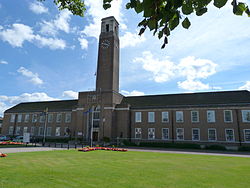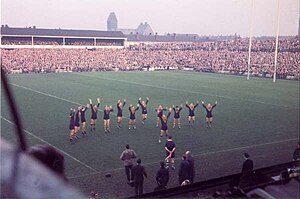Swinton, Lancashire
| Swinton | |
| Lancashire | |
|---|---|
 Salford Civic Centre, in Swinton | |
| Location | |
| Grid reference: | SD775015 |
| Location: | 53°30’44"N, 2°20’28"W |
| Data | |
| Population: | 25,362 (2011) |
| Post town: | Manchester |
| Postcode: | M27 |
| Dialling code: | 0161 |
| Local Government | |
| Council: | Salford |
| Parliamentary constituency: |
Salford and Eccles |
Swinton is a town in Lancashire, standing on gently sloping ground on the south-west side of the River Irwell, 3½ miles west-north-west of Salford, and 4¼ miles west-north-west of Manchester. It adjoins the towns of Pendlebury and Clifton. At the 2011 Census, Swinton had a population of 25,362.[1]
For centuries Swinton was a small hamlet in the township of Worsley, ancient parish of Eccles and hundred of Salfordshire.[2] The name Swinton is derived from the Old English "Swynton" meaning "swine town".[2] In the High Middle Ages, Swinton was held by the religious orders of the Knights Hospitaller and Whalley Abbey. Farming was the main industry , with locals supplementing their incomes by hand-loom woollen weaving in the domestic system.[2]
Collieries opened in the Industrial Revolution and Swinton became an important industrial area with coal providing the fuel for the cotton spinning and brickmaking industries. Bricks from Swinton were used for industrial projects including the Bridgewater Canal, which passes Swinton to the south. The adoption of the factory system facilitated a process of unplanned urbanisation in the area, and by the mid-19th century Swinton was an important mill town and coal mining district at a convergence of factories, brickworks and a newly constructed road and railway network.[3]
Contents
History
In 1817 some Swinton weavers joined in the Blanketeers' demonstration and marched to London to put their grievances to the Prince Regent. In 1842 some Swinton people took part in Chartist agitations and tried to destroy a local colliery.
Sunday schools and libraries were established in Swinton at quite an early period. The Swinton Industrial School was visited by Charles Dickens. The school was created by the Manchester Poor Law Union. In contrast with other institutions for the poor around that time, which were places of final resort, the Swinton Industrial School was built in response to a more enlightened attitude. The Manchester Poor Law Union saw the value of a place where children could be cared for and educated.[4] The school opened in 1843 and survived until the 1920s. During demolition of the school buildings in the early 1930s, the foundations proved particularly difficult. Finally explosives were used, which resulted in a huge number of rats being disturbed. It was a number of weeks before council workers could remove the rats from the surrounding streets and houses. Huge nests of baby rats were carried out of the rafters of many buildings. The site was used for the present town hall.
Landmarks
The architectural centrepiece of the town is the neoclassical Salford Civic Centre, which has a 125-foot-high clock tower.[5] It was built as Swinton and Pendlebury Town Hall. Before its construction, council meetings were held in Victoria House in Victoria Park, but the borough council required larger premises. A competition was launched to design the new town hall; the winners were architects Percy Thomas and Ernest Prestwich with a design that closely resembled Swansea Guildhall. It later won the RIBA Gold Medal.[6]The site of the former Swinton Industrial School on Chorley Road was purchased for £12,500 and the foundation stone of the new town hall laid on 17 October 1936. The main builders were J. Gerrard's and Son of Pendlebury. The town hall opened on 17 September 1938. Extensions were built when it became the administrative headquarters of the City of Salford in 1974.
Wardley Hall is an early mediæval manor house and a Grade I listed building, and is the official residence of the Roman Catholic bishops of Salford.[7]
Transport
Swinton is served by two railway stations on the Manchester to Southport Line. Swinton railway station is near the town centre on Station Road (B5231), just over the boundary in Pendlebury. The other station is Moorside near the top of Moorside Road, close to its junction with Chorley Road (A6). Until 1974 it was known as Moorside and Wardley.
Sports
Swinton RLFC has an impressive record in rugby league considering the size of the town. The club's six Championship and three Challenge Cup wins is better than the record of their local rivals Salford RLFC. The club was based in the town until 1992, when financial mismanagement necessitated a move from the Station Road ground to play at Gigg Lane in Bury. The financial failure of main creditor and de facto owner Hugh Eaves in 2002 put the future of the club in jeopardy and it spent a short time regrouping at Moor Lane in Kersal, as tenants of Salford City F.C.. From 2003, the Lions played home games at Sedgley Park RUFC in Whitefield. In 2006, the club acquired land to build a 6,000 capacity stadium with training facilities and community use in Agecroft, Pendlebury. After ground-sharing with Leigh Centurions, Salford Red Devils and Widnes Vikings,[8] the club moved to Heywood Road, Sale for the 2016 season.Swinton based junior association football side Deans F.C. was the starting point in the career of Ryan Giggs, who grew up in neighbouring Pendlebury and went on to become a Manchester United player, and also of Dean Holden.
Notable people
Composer Sir Peter Maxwell Davies, previously Master of the Queen's Music, was brought up in Swinton after his family moved from Salford when he was four.[9] In 1998, he wrote Swinton Jig, an orchestral work inspired by the sounds and traditional melodies heard in Swinton during his childhood.[10]
The composer and pianist Roger Smalley was born in Swinton in 1943.[11]
References
Notes
- ↑ "Town population 2011". http://www.citypopulation.de/php/uk-england-northwestengland.php?cityid=E35000278. Retrieved 8 January 2016.
- ↑ 2.0 2.1 2.2 Cooper 2005, p. 137.
- ↑ Cooper 2005, p. 138.
- ↑ "Swinton Industrial School - how paupers were educated in 19th century Manchester". http://www.bbc.co.uk/radio4/history/making_history/makhist10_prog11c.shtml. Retrieved 9 April 2012.
- ↑ http://www.salford.gov.uk/council/councillors/mayor/civichistory/civiccentre.htm salford.gov.uk
- ↑ Salford City Council website Salford Civic Centre Updated 16 July 2010 (retrieved 2011-11-13)
- ↑ Salford Diocese, Salford Diocese, http://www.salforddiocese.org.uk, retrieved 16 July 2011
- ↑ "Swinton Lions return to Leigh Sports Village for 2014 season". http://www.leighsportsvillage.co.uk/swinton-lions-return-to-leigh-sports-village-for-2014-season/. Retrieved 11 January 2015.
- ↑ Moss, Stephen (19 June 2004). "Sounds and silence". The Guardian (London). http://www.guardian.co.uk/music/2004/jun/19/classicalmusicandopera.proms2004.
- ↑ Swinton Jig (on a Nineteenth Century Lancashire Fiddle Tune) for orchestra, maxopus.com
- ↑ http://www.rogersmalley.com/
Bibliography
- Cooper, Glynis (2005), Salford: An Illustrated History, The Breedon Books Publishing Company, ISBN 1-85983-455-8
- Mills, David (1976), The Placenames of Lancashire, Batsford, ISBN 0-7134-5236-6
Outside links
| ("Wikimedia Commons" has material about Swinton, Lancashire) |


